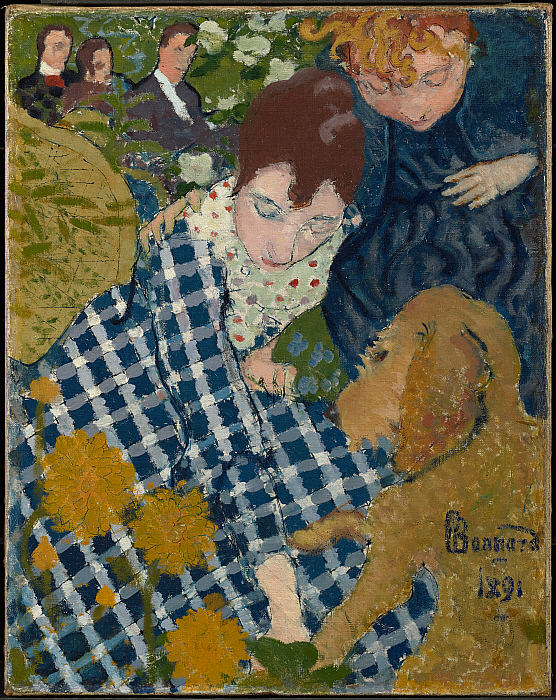
Curating Private Lives
Tags for: Curating Private Lives
- Magazine Article
- Exhibitions
Two curators thousands of miles apart collaborate on a show that depicts everyday life in Paris at the turn of the 19th-century
Heather Lemonedes Brown, Virginia N. and Randall J. Barbato Deputy Director and Chief Curator
April 1, 2021
Appears in Cleveland Art, Spring 2021

Woman in a Striped Dress 1895. Édouard Vuillard (French, 1868–1940). Oil on canvas; 65.7 x 58.7 cm. National Gallery of Art, Washington, DC, Collection of Mr. and Mrs. Paul Mellon, 1983.1.38. Courtesy National Gallery of Art, Washington, DC. © 2021 Artists Rights Society (ARS), New York / ADAGP, Paris
In the spring of 2016, co-curator Mary Weaver Chapin and I first began brainstorming the exhibition that would become Private Lives: Home and Family in the Art of the Nabis, Paris, 1889–1900. We were attending an annual conference of the Print Council of America, a professional organization of curators and conservators who focus on works on paper, and she told me that she wanted to curate a major exhibition focusing on the art of the Nabis, a group of artists active in Paris during the last decade of the 19th century. Inspired by Paul Gauguin and the growing current of Symbolism in literature and theater, the young artists called themselves Les Nabis—Hebrew for “the prophets”—to articulate their desire to create a new art of suggestion and emotion.
Mary, curator of prints and drawings at the Portland Art Museum in Oregon, recognized that both Portland’s collection and that of the Cleveland Museum of Art contain major works of art made by the Nabis. By joining our collections, and borrowing paintings and prints from other museums and private collectors, we realized we had the capacity to tell an original story about these artists whose works of art celebrate what Pierre Bonnard referred to as the small pleasures and “modest acts of life.”
Image

Mary and I first met at the Metropolitan Museum of Art in 1997. She was an intern researching the exhibition The Private Collection of Edgar Degas, and I was the study room supervisor in the Department of Prints and Drawings. As graduate students studying 19th-century French art, we recognized each other as kindred spirits. Throughout the next two decades, we remained in contact as Mary worked at the Art Institute of Chicago, the Milwaukee Art Museum, and the Portland Art Museum and as I worked at Christie’s New York and the Cleveland Museum of Art. Mary became a noted expert on Henri de Toulouse-Lautrec; she co-curated Toulouse-Lautrec at Montmartre, a major exhibition at the Art Institute of Chicago and the National Gallery of Art, Washington, DC, which won the Association of Art Museum Curators Annual Prize for Best Museum Exhibition in 2005. In 2012, she curated Posters of Paris: Toulouse-Lautrec and His Contemporaries, mounted at the Milwaukee Art Museum and the Dallas Museum of Fine Arts. In Cleveland, I co-curated Paul Gauguin: Paris, 1889, which traveled to the Van Gogh Museum, Amsterdam, and curated British Drawings at the Cleveland Museum of Art. When we recognized the opportunity to collaborate, we proposed an exhibition on the art of the Nabis.
We spent 2017–18 refining the theme of our project, deciding to focus on the way four of the Nabis—Pierre Bonnard, Maurice Denis, Félix Vallotton, and Édouard Vuillard—depicted interiors, family, friends, pets, and domestic gardens in their paintings, drawings, and prints. In 2019, we finalized the checklist and visited museums and private collections in New York, Boston, Chicago, Amsterdam, Paris, London, Geneva, and Washington, DC, viewing works of art and asking for loans.
Image

The next year, when it was time to write our catalogue essays, we found ourselves in the midst of a global pandemic. With books borrowed from libraries and purchased online, along with obscure reference materials obtained by resourceful librarians, we wrote our texts while sheltering in place. Mary penned her essays on a card table in her Portland bedroom, while I wrote in my attic office in Cleveland Heights. Every Friday afternoon we met on Zoom, discussing positive responses to our loan requests and how to cope with occasional rejections, and providing feedback on each other’s essays.
The irony of writing about the Nabis’ depictions of domestic interiors and family life in late 19th-century Paris while we were cloistered in our early 21st-century homes, surrounded by our own families and pets, did not escape us. At last, this summer Mary and I will share the Nabis’ artistic responses to home, family, and friendship with audiences at the Cleveland Museum of Art.
Image

Cleveland Art, Spring 2021
Related Content
Private Lives: Home and Family in the Art of the Nabis, Paris, 1889–1900
Tags for: Private Lives: Home and Family in the Art of the Nabis, Paris, 1889–1900
- Special Exhibition
Private Lives: Home and Family in the Art of the Nabis, Paris,1889–1900 explores the beautiful, enigmatic, and paradoxical...
